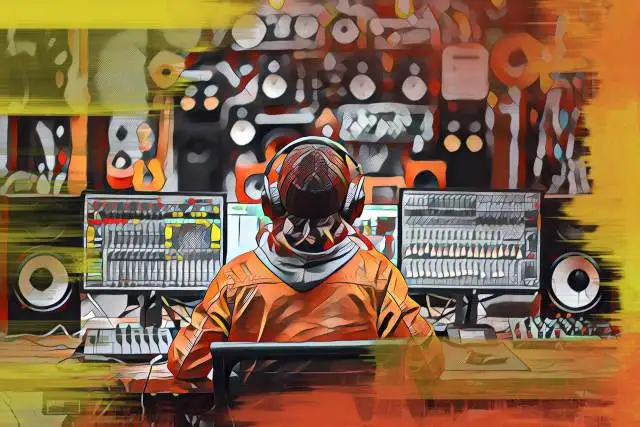If you're a producer or mix engineer who has any experience with digital audio, there's no doubt you've come across filters. While they might sound like a single, easily definable entity, digital filters come in all shapes and sizes, and as tools, they help us tweak and control specific frequencies in our audio. Just like the way we might boost or cut with an EQ, filters do the same thing but with more intensity. They’re precise, flexible, and absolutely essential when it comes to shaping sound.
But what exactly are digital filters and how do they work?
At their core, they’re algorithms that either reduce or amplify certain frequency ranges in your audio signal . You can use them to cut out unwanted low-end rumble in a vocal recording or boost shimmering high-end sparkle in an acoustic guitar recording. In a nutshell, they give you the ability to clean up, sculpt, or completely transform a sound, making them a key part of any producer’s toolkit.
Now, why are filters so important in music production, and why as a beginner producer should you care? Well, they play a huge role in tone shaping . Whether you're mixing vocals, creating your own synth patch from scratch, or sculpting that perfect kick drum sound, filters give you precision control over the tonal balance of your track. Without them, things can get muddy, unclear, or just downright unpleasant to listen to.
Filters come into play at every stage of production. During recording, we can use them to get rid of any unwanted highs or lows that may not contribute to the overall sound. During mixing, you can use them to remove unnecessary frequencies or to carve out space between instruments. In mastering, filters help fine-tune the overall balance of a track, while in sound design, they’re perfect for creating anything from subtle effects to wild, sweeping changes.
If you have an understanding of the different types of filters and how to use them, you have a creative advantage. In this guide, we'll look at all you could ever want to know about digital filters, so you can start using them in your music-making process like a pro.
What Are Digital Filters?
Before we get into the different types of filters, let's first break down the basics of what digital filters are and how they work. If you've ever wondered how some of your favorite music producers and mixing engineers seem to magically shape sounds into something so pristine and clear, filters are a big part of that trick. It’s not magic, however, it’s just a little bit of science.
To understand filters, though, you need to first understand digital signal processing . Every sound you hear, whether it’s a snare drum, a guitar riff, or a vocal line, exists as a collection of frequencies. These frequencies range from low (like the sub frequencies of a bass guitar) to high (like the shimmer of a ride cymbal).
With digital signal processing, we can manipulate these frequencies however we want. This is where digital filters come into play. They give us a way to control which parts of the frequency spectrum are heard, which are reduced, and which are completely removed.
Digital filters are made to manipulate specific frequency ranges in your audio. For example, you can use a digital filter to remove all the low-end frequencies from a track, leaving only the higher frequencies. This can be super handy if, say, your vocal track is sounding a bit muddy because of some unnecessary bass frequencies. You’ve got three main zones: low , mid , and high frequencies, and filters can target any of these depending on what you need.
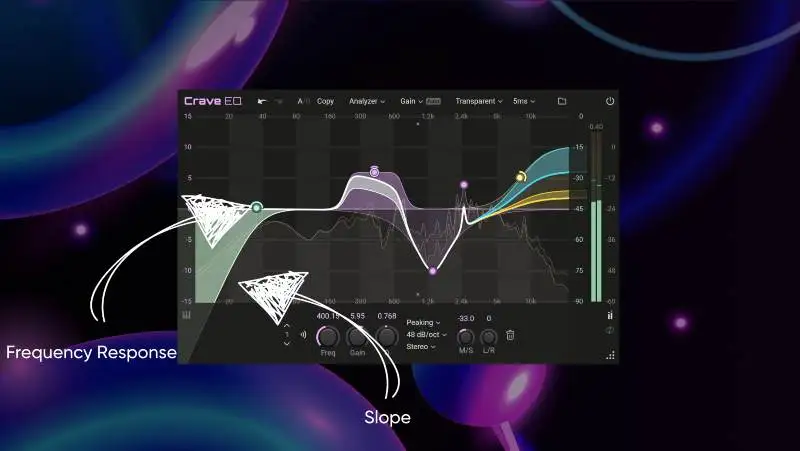
When you're working with filters, you'll often hear terms like frequency response and filter slope . The frequency response tells you how a digital filter affects different frequencies , whether you're boosting, cutting, or leaving them untouched, while the filter slope refers to how sharply the filter transitions from passing to cutting frequencies . A steep slope (like 24 dB per octave) will give you a more aggressive cut, while a gentle slope (like 6 dB per octave) makes a smoother transition.
There are a few other common parameters you'll see on filters, including:
- Cutoff frequency : This is the point where the filter starts working. For a low-pass filter, for example, the cutoff frequency would mark where the highs start getting rolled off.
- Resonance : This boosts the frequencies right around the cutoff point, which can add a bit of character or "bite" to your sound.
- Q factor : Affects how narrow or wide the frequency range affected by the filter is. A high Q factor means a very narrow band and a low Q affects a wider range.
And just in case you were wondering about the difference between analog and digital filters , analog filters are built into hardware (old-school synthesizers, guitar pedals, etc.), while digital filters exist as software or plugins in a DAW. Digital filters tend to offer more precision and flexibility, but analog filters can add a certain warmth or color to the sound that many people love. Each has its place in music production, but these days, digital filters are more common because of their accessibility.
Types of Digital Filters
Digital filters come in different flavors, but they generally fall into two categories: frequency-based and purpose-based .
Frequency-based filters work by targeting specific parts of the frequency spectrum. These typically include low-pass , high-pass , band-pass , and notch filters. Each of these helps manipulate the incoming sound by allowing certain frequencies to pass while cutting others.
Then, we have purpose-based filters , which are designed for more specialized tasks, like dynamic filters , which respond to the signal’s volume, or shelving filters , which boost or cut a whole range of frequencies above or below a certain point. There are also comb filters that create unique, phase-shifted effects by delaying the signal just slightly.
Different filters are useful in different parts of music production and mixing, so whether you're cleaning up a messy mix or getting in the weeds with sound design, each type of digital filter has its role to play.
Frequency-Based Filters
For shaping the sound of your mix or an individual element within your mix, frequency-based filters are some of the most important tools in your arsenal. These filters allow you to focus on different parts of the frequency spectrum, including the lows, highs, mids, and everywhere in between.
Each digital filter type has its own unique function as well. Let's take a look at some of the most commonly used.
Low-Pass Filter (LPF)
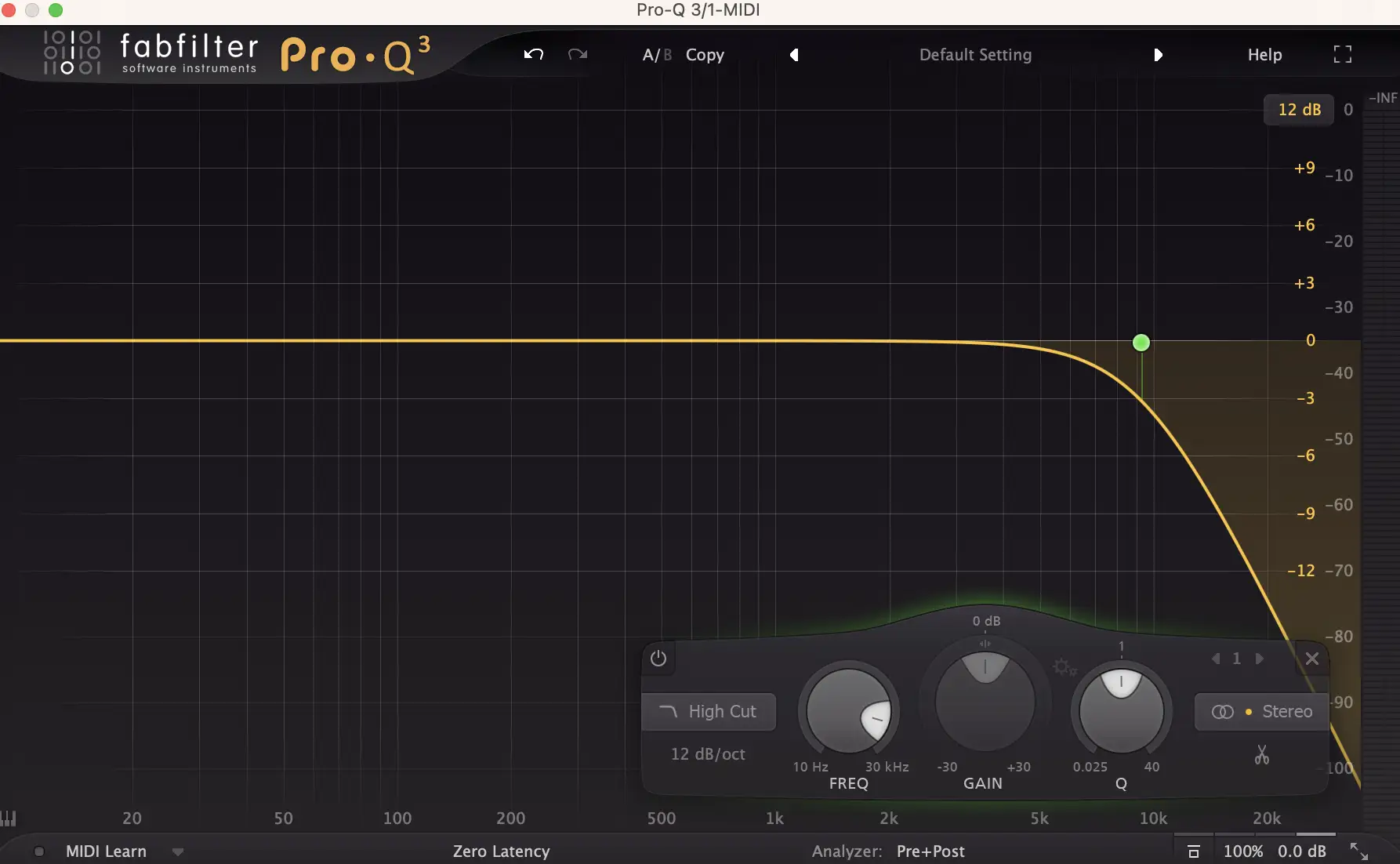
A low-pass filter (LPF) does exactly what it sounds like. It lets the low frequencies pass through while cutting the higher ones. It’s one of the most commonly used filters in music production, and it’s great for creating a smooth, rounded-off sound. The LPF works by setting a cutoff frequency , which is the point where it starts to reduce the volume of frequencies above that point.
You’ll often hear low-pass filters in action when you want to remove unwanted high-frequency noise or create a more mellow sound. For example, a synth pad (especially a digital one from a VST) might sound too bright and harsh with all the high-end intact. By applying a low-pass filter, you can roll off those higher frequencies, making the sound warmer and more blended into the mix.
Low-pass filters are also often used in lo-fi music to create that classic muffled sound, which simulates older, degraded audio equipment.
I often find myself applying low-pass filters to my basslines . Sometimes, a bass guitar or bass synth might have too much high-end content that clashes with other elements in your track. A low-pass filter can smooth out the top end, leaving only the deep, rich bass frequencies you want.
I'll even use it on electric guitar a lot of the time to get the high frequencies out of the way of my vocals. You'd be surprised by how much you can roll off the top of a sound in a dense mix before it becomes noticeable.
High-Pass Filter (HPF)
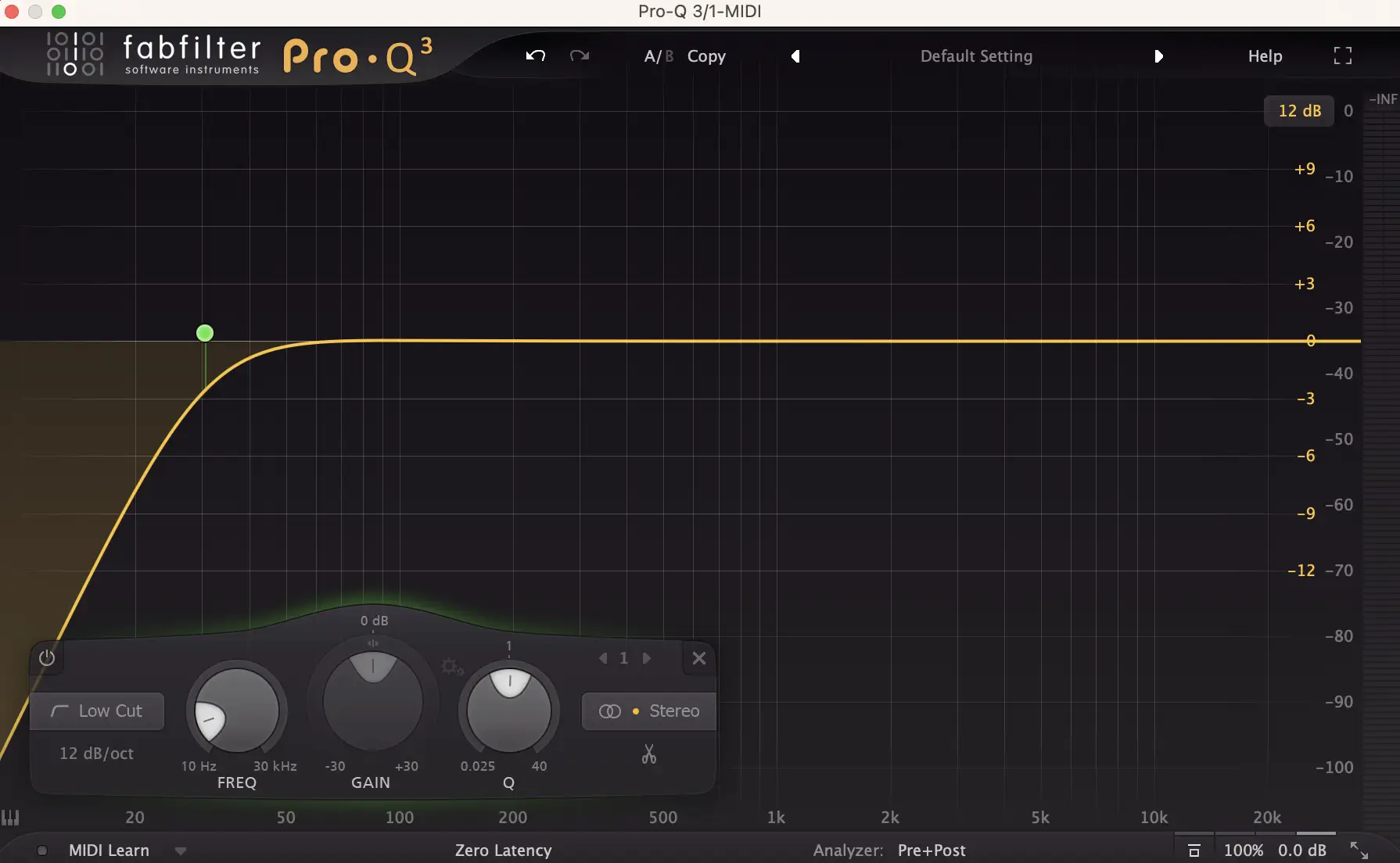
On the flip side, a high-pass filter (HPF) allows the high frequencies to pass through while cutting the lows. This is one of the go-to tools for cleaning up low-end rumble or removing excess bass from tracks where it’s not needed. Like low-pass filters, high-pass filters work by setting a cutoff frequency . However, the difference is that everything below that frequency gets reduced.
A high-pass filter can be incredibly useful for a vocal recording. Let’s say you’ve got a vocal track with some low-frequency noise, such as hum from air conditioning or handling noise from the mic. With a high-pass filter, you can cut out those unnecessary lows while keeping the clarity of the higher frequencies intact. This technique is also great for tightening up hi-hats and cymbals, which often don't need a lot of extra weight in the low-end dragging them down.
I also commonly use high-pass filters on my guitar tracks . Both electric and acoustic guitars can carry a lot of low-frequency content, depending on the way they are recorded, and can compete with the bass or kick drum. A quick pass with a high-pass filter can remove that unnecessary low end, leaving room for the more important bass frequencies in the mix.
Band-Pass Filter (BPF)
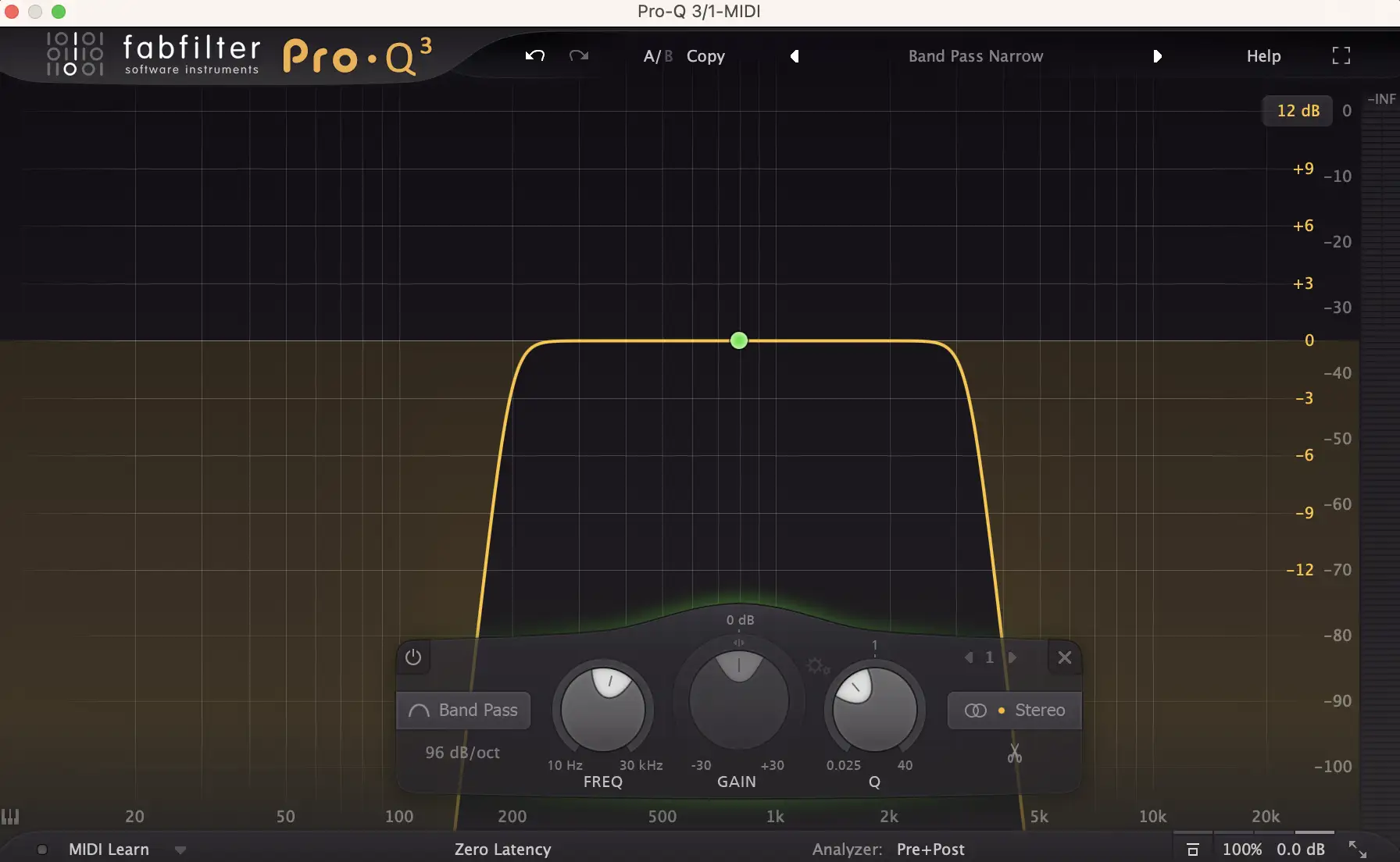
A band-pass filter (BPF) takes things a step further by allowing only a specific range (or band) of frequencies to pass through while cutting both the highs and the lows. This can be incredibly useful when you want to isolate and emphasize a particular frequency range, creating a more focused sound. I often think of a band-pass filter as a specialist filter, as it's typically used for more creative purposes in music production.
One of the most popular and possibly overused examples is the telephone effect you often hear on vocals in songs. This effect makes the voice sound like it's coming through a phone line by using a band-pass filter to isolate the mid-range frequencies (around 300-3000 Hz) and cut everything else. This can add a unique, lo-fi quality to the vocal that stands out in a mix.
In sound design , band-pass filters are also great for stacking synth sounds. By narrowing down the frequency range in a specific synth patch, you can create sharp, precise sounds that fit into specific pockets of your mix. This is especially useful for creating resonant sweeps , where the cutoff point of the band-pass filter is automated to sweep up or down through the frequency range.
You can also use a band-pass filter to clean up your reverb and delay sends.
Notch Filter (Band-Stop Filter)
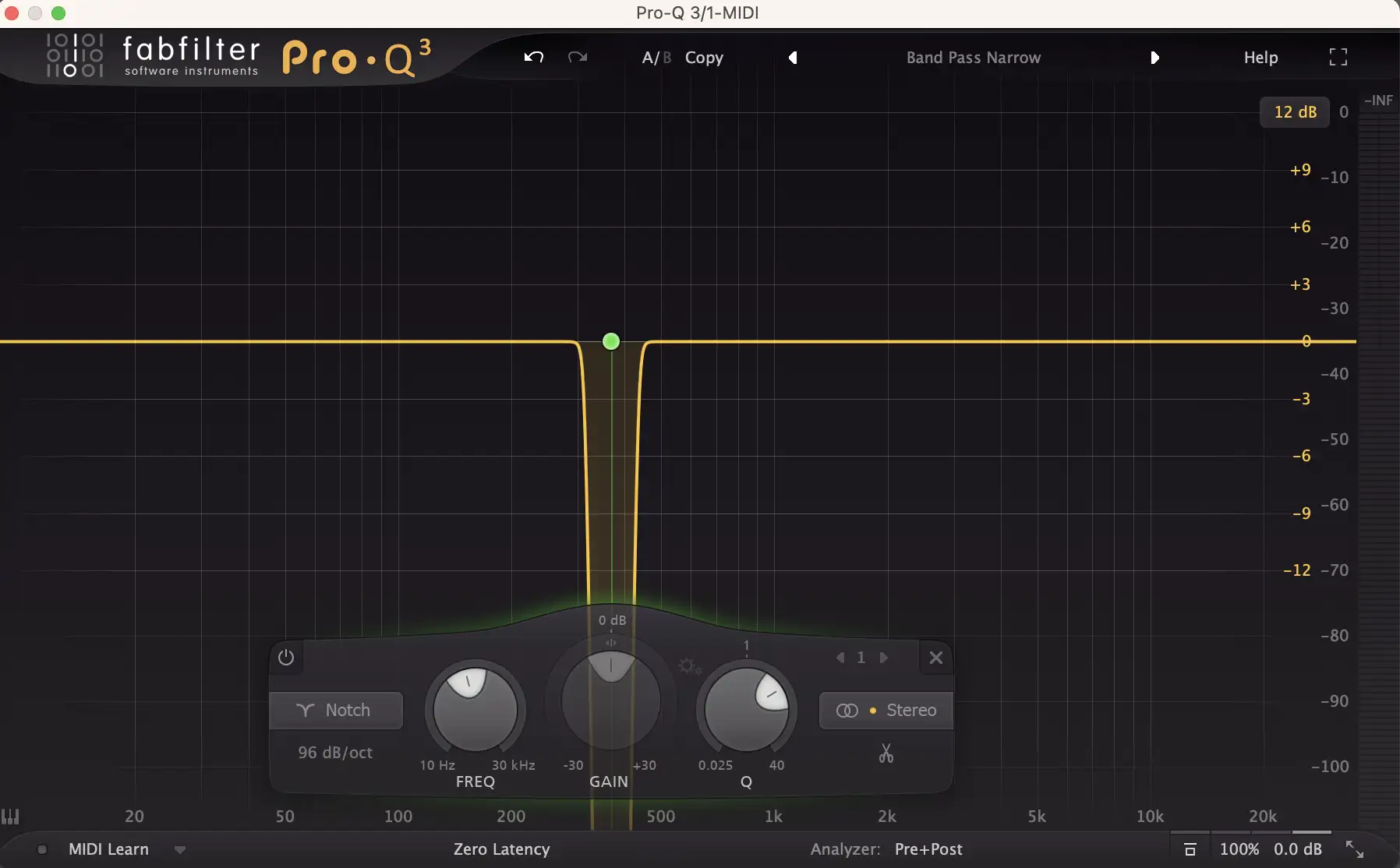
Finally, we have the notch filter , also often called the band-stop filter . I like to think of this as the polar opposite of the band-pass filter. It cuts out a very narrow band of frequencies and leaves everything else untouched. This makes the notch filter perfect for solving very specific problems, like removing unwanted hums or resonant peaks without affecting the rest of your sound.
One of the most common uses for a notch filter, however, is eliminating feedback in live sound situations . Feedback happens when certain frequencies from a microphone loop back into the system and create a high-pitched squeal. A notch filter can be used to target and remove that frequency while leaving the rest of the audio signal intact.
In mixing, on the other hand, notch filters are great for fixing problematic frequencies in bad recordings. You might have an acoustic guitar recording with a nasty room tone around 550 Hz. Instead of using a wide filter that cuts out that frequency and a bunch of other frequencies around it that might be desirable to the overall sound, a notch filter can target just the 550 Hz resonance and leave the rest of your mix unaffected.
Purpose-Based Filters
Beyond the standard frequency-based digital filter types, there are some specialized filters that serve more targeted roles in music production and mixing. These filters are often used for tonal adjustments, sound design, or creative effects.
While they may not be as common in every mix, they can make a big difference when you need a very specific result. Let’s take a look at some of the most widely used purpose-based filters and what kinds of roles they play in production.
Shelving Filter
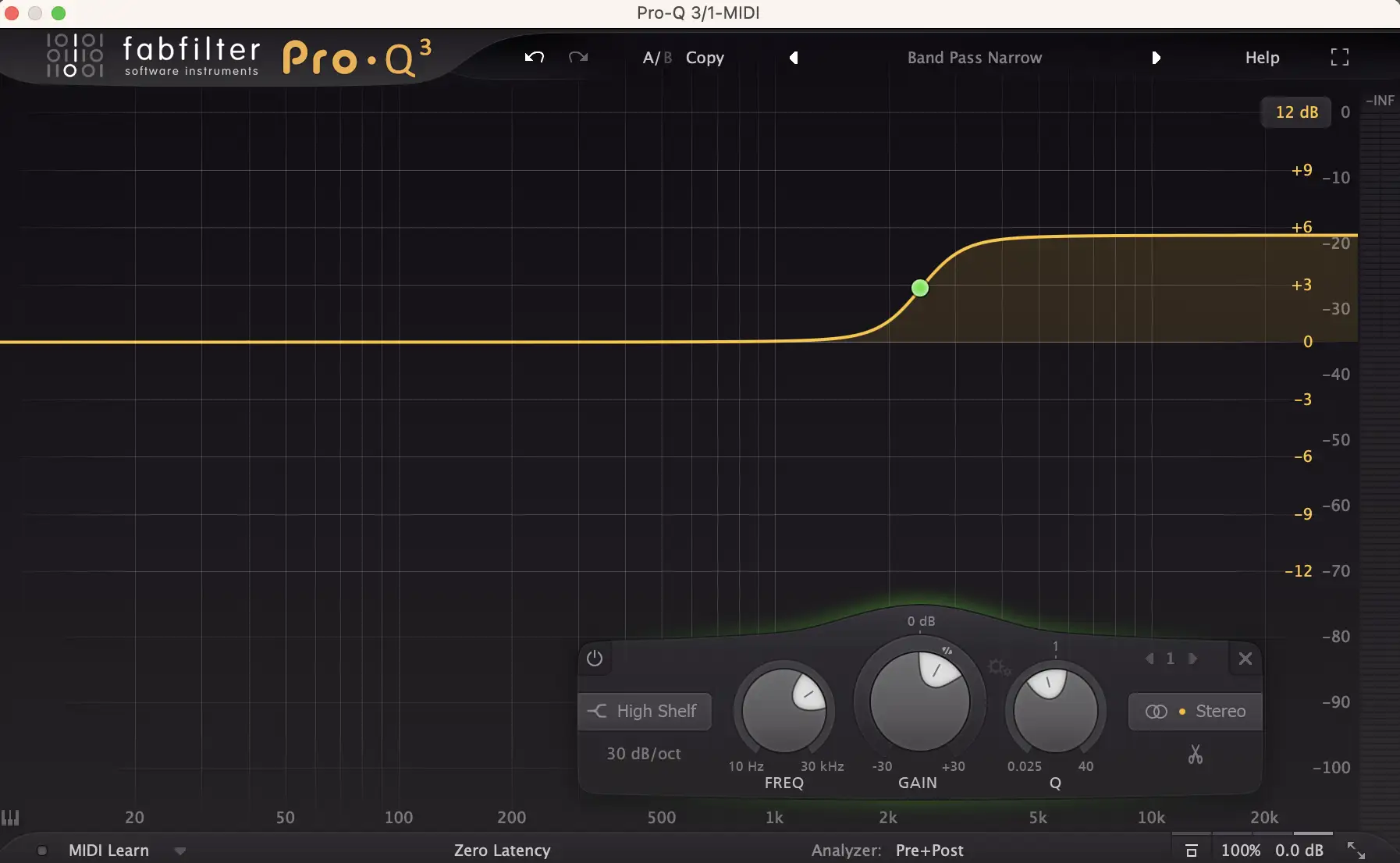
A shelving filter is designed to either boost or cut frequencies above or below a certain point, which is why it's so ideal for broad tonal adjustments. Instead of gradually cutting or boosting a narrow range of frequencies, as you would with a band-pass or notch filter, shelving filters affect an entire range of frequencies above or below the set cutoff frequency .
For example, if you apply a low-shelf filter to boost the low frequencies below 100 Hz, it will raise the entire bass range without touching the higher frequencies. Similarly, a high-shelf filter will boost or cut everything above a chosen frequency point. These filters are great for mastering, especially when you want to make subtle changes to the overall tonal balance of a track.
Shelving filters also come in handy when you’re broad-shaping the tone of an instrument or vocal. For example, if you want a little more meat in your kick drum, you can boost the low end around 60 Hz with a low-shelf filter. Or, if you need to brighten up a vocal track without adding a ton of harshness or sibilance, you can use a 10 kHz high-shelf filter to add a bit of extra sparkle.
Comb Filters
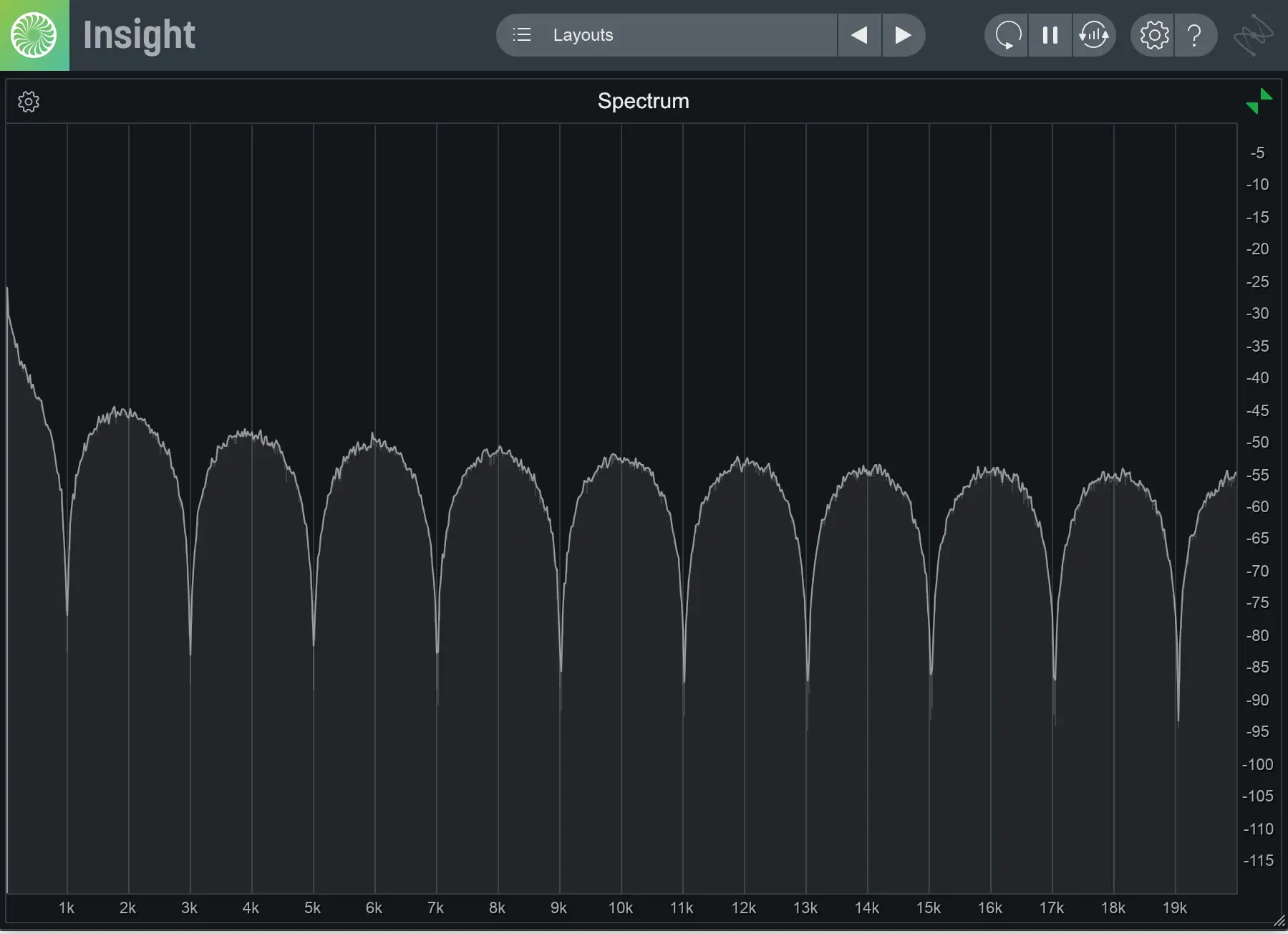
The comb filter creates some of the most unique and distinct sounds you’ll hear in music production. It works by introducing a delayed version of the original audio signal and then combining the two. This digital filter causes phase interference , which creates a series of notches and peaks in the frequency response. The result is a sound that’s reminiscent of a “comb,” hence the name. It has a thin, almost metallic quality that gives your output signal a sense of movement.
Comb filters are typically used for special effects, particularly when you want to create a flanging or chorus-like effect. When the delayed signal’s time shifts slightly (a few milliseconds), you get a sweeping or “whooshing” sound that’s often heard in experimental or psychedelic electric guitar tones. In a similar way, you can apply a comb filter to a vocal to get a robotic or electronic effect.
In sound design, however, this digital filter can be used to create evolving synth textures, especially if the parameters are automated. When you slowly adjust the delay time and feedback, you can create some pretty wild effects.
Dynamic Filters
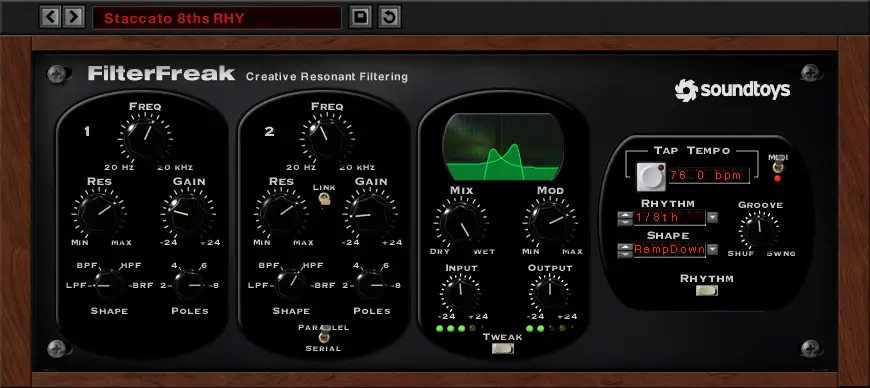
A dynamic filter adjusts its cutoff frequency in response to the input signal. Instead of setting a fixed point like you would with a static filter, a dynamic digital filter will move in real time based on factors such as the amplitude (volume) or envelope of the signal. This leaves things nice an open-ended.
One of the most classic examples is the auto-wah effect, which automatically adjusts the filter’s cutoff point as the input signal changes. The harder you play, the more the filter opens up, giving you that iconic funky wah sound.
Formant Filters
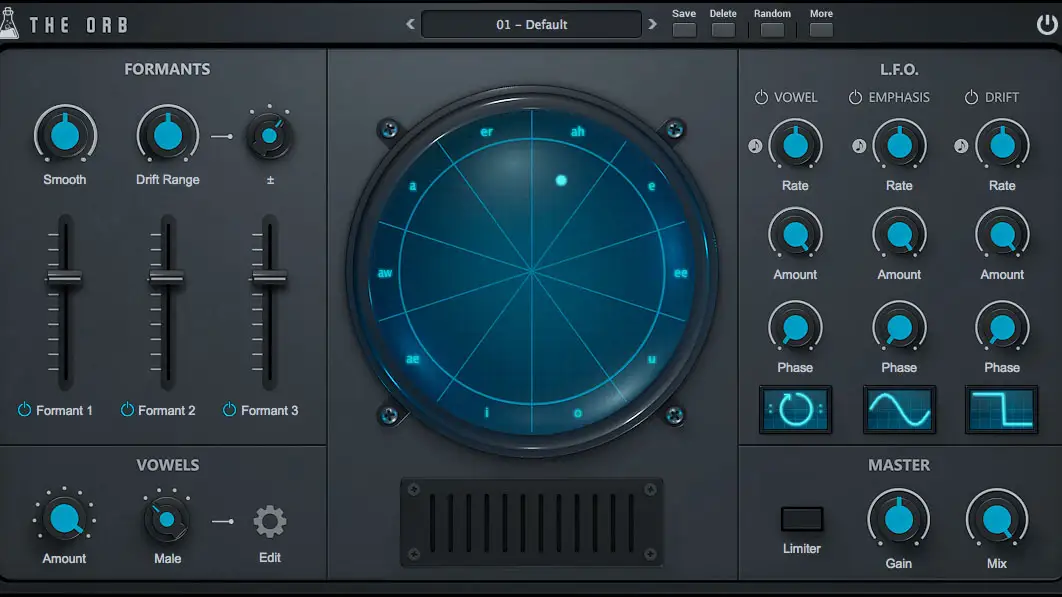
Formant filters are a bit different from your typical EQ or frequency-based digital filter, as they're designed to simulate the resonant frequencies of the human voice. A formant is essentially the set of resonant frequencies that define vowel sounds, and with formant filters, you can manipulate your input signal to mimic those vocal characteristics.
In electronic music, formant filters are often used for creating robotic, alien, or vocoder-style effects. By adjusting the filter to match the formant frequencies of different vowel sounds (like "aah," "eeh," or "ooh"), you can make a synth or any other instrument sound like it's talking or singing.
Listen to the beginning of Toro Y Moi's "Lilly" for a good example of a formant filter in action:
The Role of Filters in Modern Music Genres
Filters play a surprisingly big role in shaping the distinct sounds of different music genres that we know and love. Let's take a closer look at how various genres use filters to achieve their signature sound.
Electronic Music (EDM, House, Techno)
In electronic music, filters are a major part of the creative process. Low-pass filters are often used to create dramatic sweeps and risers while clearing up low-end for important elements like kicks and basses.
In genres like house and techno , filters also help shape the movement of a track. Producers often use high-pass filters on drum loops or synth basslines to cut out the low frequencies before slowly bringing them back in to create anticipation before a drop.
Hip-Hop
In hip-hop , filters play an important role in achieving that classic, vintage sound, especially when working with sample-based beats . Low-pass filters are often used to cut out the high frequencies from samples to give them a warm, old-school feel.
Producers might also apply filters to isolate certain frequencies in a sample so they don't interfere with the main vocal.
Pop
In pop music , filters are super important for getting a polished, radio-friendly sound. For example, a high-shelf filter might be used to boost the high-end frequencies of a pop vocal to give it that luxurious brightness we're so used to hearing on Top 40 tracks.
Advanced Digital Filter Techniques
Once you've mastered the basics of using filters, there are plenty of advanced techniques you can begin exploring.
Filter Modulation and Automation
Modulating filters over time is a great way to add movement to a track. With LFOs or envelopes, you can automate the way a filter opens and closes, creating constantly evolving synths or pads.
For example, if you apply an LFO to the cutoff frequency of a low-pass filter, you can create a pulsing or sweeping effect for added motion in an otherwise static sound. In a similar way, you can use an envelope to create dynamic changes in your filter's behavior, with the filter opening as a sound gets louder and closing as it gets quieter. You'll often hear this technique in the form of an automated low-pass filter sweep in house and dubstep, as it creates a nice build-up and release for drops and transitions.
Filter Stacking and Parallel Processing
Filter stacking is when you apply multiple filters to a sound for more precise control over its frequency content. For instance, you might use a high-pass filter to cut out low-end rumble while simultaneously using a low-pass filter to tame harsh high frequencies.
I also like to use filters in parallel processing . I'll split the audio signal into two or more parallel paths, apply different filters to each path, and then blend them back together. For example, I might apply a high-pass filter to one copy of a bass track to keep just the mid and high-end details while using a low-pass filter on another copy to focus on the deep bass frequencies. Then, I'll blend the two filtered versions together to get a full-bodied sound.
Final Thoughts
There you have it - your beginner digital filters guide! From basic high-pass and low-pass filters to more advanced filtering techniques like modulation and parallel processing, filters allow us to shape sound in ways that can be both technical and highly creative.
As you continue to explore filters, don’t be afraid to experiment and push the boundaries of what they can do in signal processing.


